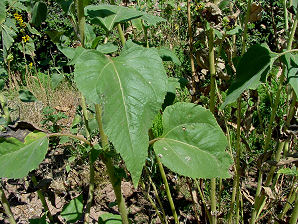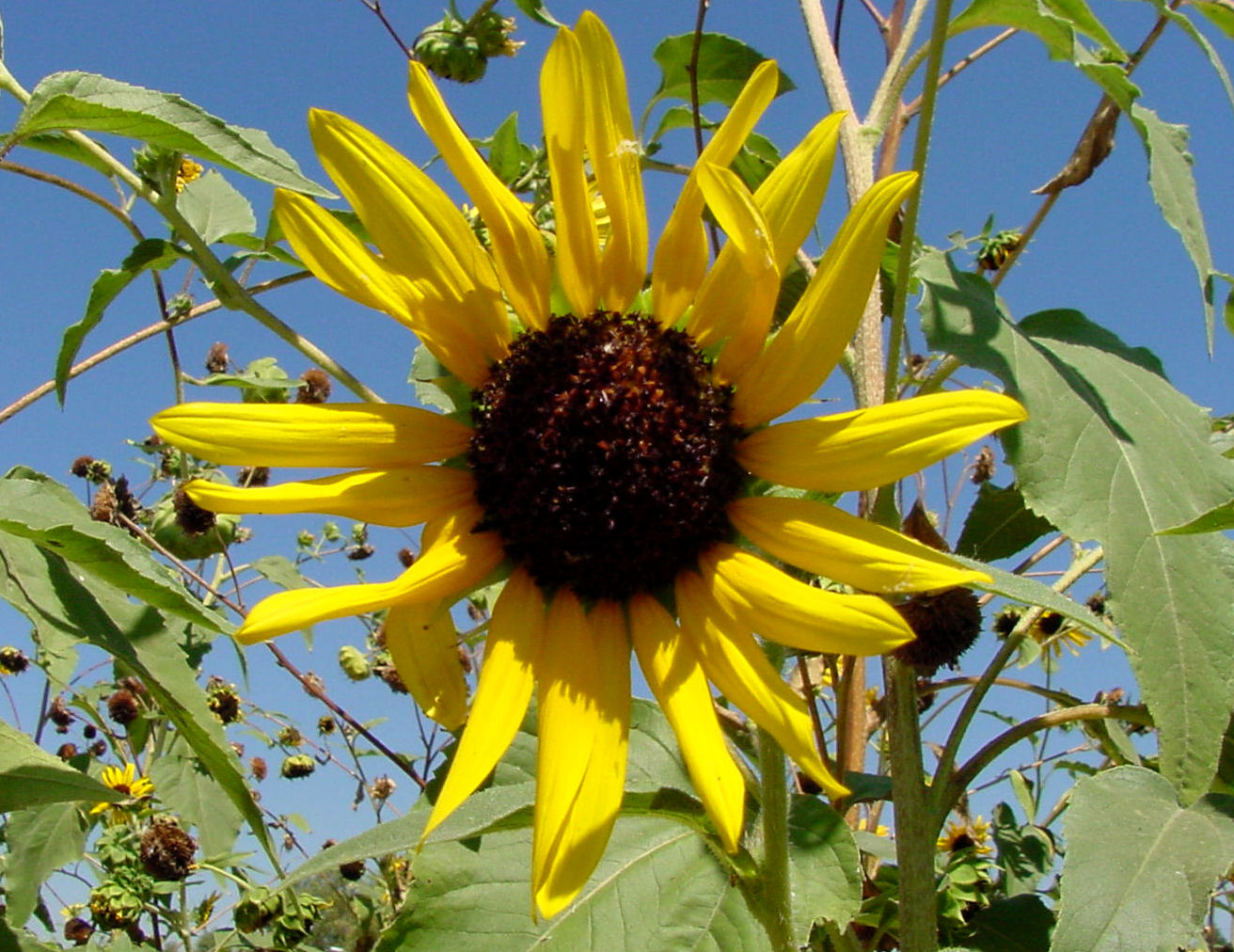Arizona Wild Flowers
Pictures, Photos, Images
Descriptions, Information, Reviews.
Sunflower, Helianthus annuus.
We Are Proud Of Our SafeSurf Rating!
Click On Any Of The Following Links By Amazon.Com
For Books, & Videos About Wildflowers Of Arizona & The Southwest USA. No Obligation!
 |
| Pipevine Swallowtail Butterfly, Battus philenor, On A Sunflower, Helianthus annuus. Photo Taken At Yarnell, Arizona. August 31, 2008. |
|---|
 |
| Sunflower, Helianthus annuus. |
 |  |
| Sunflowers Grow In Clumps | Sunflower Leaves |
|---|---|
 |  |
| Fresh Sunflower Blossom Source Of Pollen For The Bees | Older Sunflower Blossom |
Sunflower.
We wish to thank Wikipedia, the free encyclopedia for some of the information on this page. We share images and information with Wikipedia. The sunflower has quite a history! Evidence shows that the sunflower was first domesticated in Mesoamerica, in present day Mexico, by at least 2600 BC. It then, may have been domesticated a second time in the middle Mississippi Valley, or have been introduced there from Mexico at an early date, as maize was. The earliest known examples of a fully domesticated sunflower north of Mexico have been found in Tennessee, and date to around 2300 BC. Many indigenous peoples of the Americas, used the sunflower as the symbol of their solar deity, including the Aztecs and the Otomi of Mexico and the Incas in South America. Francisco Pizarro was the first European to encounter the sunflower in Tahuantinsuyo, Peru. These plants are called sunflowers because the flowerhead looks like the sun and because it is said that the flowerhead follows the sun across the sky. But, it is a common misconception that sunflowers track the sun! Scientific evidence proves it is not true! (Well sort of not true)! Young flowers do, and mature flowers don't! In fact, mature flowerheads typically face east and do not move. However, the leaves and buds of young sunflowers do exhibit heliotropism (sun turning). Their orientation changes from east to west during the course of a day. Experiments have shown that the movements become a circadian response and when plants are rotated 180 degrees, the old response pattern is still followed for a few days, with leaf orientation changing from west to east instead. This leaf and flowerhead bud phototropism occurs while the leaf petioles and stems are still actively growing, but once mature, the movements stop. These movements involve the petioles bending or twisting during the day then unbending or untwisting at night. Here is where it can also get confusing, and why there are so many descriptions of sunflowers, there are some 70 - 80 species of Helianthus, all native to the New World. Some are perennials, many are popular garden ornamentals, and one, Jerusalem artichoke (H. tuberosus), is grown throughout the world for its edible tubers. There are also many species in other genera that are called sunflowers. Most sunflowers have large flowerheads 8 - 12 inches across. But the flowerhead is technically not the flower. The flowers, also called florets, are nearly always clustered into flowerheads, with each subtended by a whorl or whorls of modified leaves called bracts (the involucre). There are two general forms of flowers. A disk flower, in its most complete form, has five petals fused into a tube, with a tube of five fused anthers inside the petal tube, and a two-lobed stigma exserted through the anther tube. A ray flower (a "petal" of a daisy) is similar, except that some of the fused petals extend on one side into a flat strap-like ligule. Flowers may be unisexual or sterile, lacking either or both "male" and "female" sexual parts. Each functionally "female" flower, whether ray or disk, has a single inferior ovary with a single ovule. If the ovule is fertilized, it will develop into a single seed in a special fruit called an achene. Each head may have only ray flowers or disk flowers, or both. Regarding their height, scientific literature has been found, which reports that a 40 foot tall, traditional, single-head, sunflower plant was grown in Padua, northern Italy, in 1567. It is said that the same seed lot normally grew to almost 26 feet tall at other times and places, including Madrid, Spain. During the 20th century, heights of over 24 feet have been achieved in both the Netherlands and Ontario, Canada.
Quick Notes:
Height: Growing about 4 to 10 feet tall. Many species of sunflowers can reach 8 - 15 feet in height.
Flowers: Flowerheads usually 3 - 4 inches across, some can become much larger, ( 8 - 12 ) inches; yellow ray florets and purplish brown disk florets. The ray florets of sunflowers are sterile, and only the disk florets produce seeds.
Flowering Time: April - November.
Leaves: The leaves are bright, evergreen lance-ovate, egg-shaped, or heart-shaped, simple leaves, and up to 12" long. The stems and leaves are covered with hairs.
Found: Native to all of the Americas. Found throughout different elevations in Arizona.
Hardiness:
Soil pH requirements:
Sun Exposure:
Elevation: 0 - 11,129 Feet. In the USA 0 to 7,100 feet.
Habitat: Prefers Alkaline, Chalky/alkaline, Alkaline, well-drained/light soils. Will tolorate Acid Soils. A common plant in Arizona. Native of the New World.
Miscellaneous: Flowering Photos Taken June 29, 2005. In Glendale. Pipevine Swallowtail Butterfly Photo Taken At Yarnell, Arizona. August 31, 2008. In Peeples Valley, Arizona; we found that these plants grew all over the place during a very wet monsoon season. They "loved" the very wet conditions. This is the opposite of what many "scientific" discussions say!
|
We Are Proud Of Our SafeSurf Rating!
Click On Any Of The Following Links By Amazon.Com
For Books, & Videos About Wildflowers Of Arizona & The Southwest USA. No Obligation!
| © 1966 - Present, Audrey, Eve, & George DeLange |
